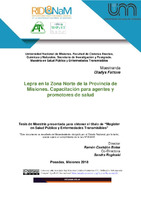Lepra en la Zona Norte de la Provincia de Misiones. Capacitación para agentes y promotores de salud
Abstract
La lepra es una enfermedad producida por Mycobacterium leprae, fue descubierta en 1874 por el médico noruego Gerhard Armauer Hansen, y por esto también se la denomina enfermedad de Hansen. Argentina está dentro de los países que han alcanzado la meta de eliminación mundial pero aún existen bolsones en algunas regiones del país donde el número de pacientes supera
ampliamente estos valores.
Se realizó un estudio de encuestas a trabajadores de la salud, para conocer el 11 estado de sus conocimientos acerca de la enfermedad. Luego recibieron una capacitación y finalmente otra encuesta, además se estableció que una vez terminada la formación los agentes sanitarios pudieran reconocer o estimar la aparición de la enfermedad y derivar a los pacientes al centro de referencia.
Posteriormente se realizó una nueva encuesta con quienes habían tenido contacto con pacientes y sus familias y de esta manera se estableció la efectividad en la detección y el reconocimiento de la enfermedad tanto en el paciente afectado como en sus familiares y contactos directos.
Como indicadores adicionales, se registraron nuevos casos sospechosos que fueron derivados al sistema provincial de salud (SPS), brindando acompañamiento del tratamiento en los pacientes diagnosticados.
El estudio se realizó en el Hospital Samic de Eldorado, Hospital de área Comandante. Andresito y Hospital de área Puerto Esperanza.
Los resultados mostraron un nivel de conocimiento de agentes de salud previa a la capacitación inferior al 5 % y luego de haber recibido información y participado de los talleres mejoraron en un rango entre el 59 y el 93 %.
La capacitación del personal sanitario contribuye a la visibilidad de esta dolencia olvidada, mejora el diagnóstico temprano, el acceso al tratamiento y a disminuir el estigma asociado a la patología. Leprosy is a disease caused by Mycobacterium leprae, it was discovered in1874 by the Norwegian doctor Gerhard Armauer Hansen, and for this reason it is also called Hansen's disease. Argentina is among the countries that have reached the goal of global elimination but there are still pockets in some regions of the country where the number of patients far exceeds these values.
A survey of health worker surveys was conducted to know the status of their knowledge about the disease. Then they received training and finally another survey, it was also established that once the training was finished, health workers could recognize or estimate the onset of the disease and refer patients to the reference center.
Subsequently, a new survey was carried out with those who had contact with patients and their families and in this way the effectiveness was established in the detection and recognition of the disease both in the affected patient and in their relatives and direct contacts.
As additional indicators, new suspicious cases were registered that were referred to the provincial health system (SPS), providing treatment support in the diagnosed patients.
The study was conducted at Samic Hospital in Eldorado, Cdte area Hospital. Andresito and Puerto Esperanza Area Hospital.
The results showed a level of knowledge of health agents prior to training less than 5% and after receiving information and articipating in the workshops they improved in a range between 59 and 93%.
The training of health personnel contributes to the visibility of this neglected condition, improves early diagnosis, access to treatment and reduces the stigma associated with the pathology.
Collections
- Maestría [30]
The following license files are associated with this item:




